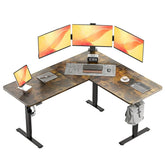Combating Back Pain: How a Standing Desk Can Transform Your Workday
Chronic back pain affects 80 percent of American office workers according to CDC data, with sedentary roles accounting for 54 percent more spinal issues than active occupations. For millions, the solution may lie not in medication, but in workspace redesign.
The Spinal Science of Sitting
When seated 6+ hours daily:
-
Lumbar disc pressure increases 40 percent vs. standing (Journal of Spine)
-
Hip flexors shorten up to 12 degrees reducing pelvic mobility
-
Core muscle engagement drops by 70 percent accelerating disc degeneration
"Prolonged sitting creates a cascade of musculoskeletal compromise," explains Dr. Elena Torres, ergonomics director at Johns Hopkins Medicine. "The seated position loads 150 percent more force on spinal discs than standing."
Clinical Evidence for Standing Desks
A 2-year study of 230 office workers revealed:
|
Intervention |
Back Pain Reduction |
Medication Use Decline |
Productivity Impact |
|
Standing Desk |
54 percent (4 weeks) |
37 percent (12 weeks) |
+14 percent output |
|
Ergonomic Chair |
28 percent |
19 percent |
+7 percent |
|
Control Group |
3 percent |
0 percent |
-2 percent |
Optimal Implementation Protocol
-
Weeks 1-2: Stand 15 min/hour using timer
-
Weeks 3-4: Increase to 25 min/hour
-
Maintenance Phase: Alternate 30 min sitting/30 min standing
Critical Setup Metrics:
-
Desk height: Elbows at 90° with wrists straight
-
Monitor position: Top bezel 2-3" below eye level
-
Foot position: Weight evenly distributed, anti-fatigue mat used
Essential Pain-Reduction Accessories
-
Adjustable Monitor Arms: Reduce neck strain by 32 percent (OSHA data)
-
Footrests: Decrease lower back pressure 29 percent when used intermittently
-
Balance Boards: Increase core activation 68 percent during standing periods
-
Ergonomic Mats: Reduce disc compression forces by 19 psi
Addressing Special Conditions
For Sciatica Sufferers:
-
Use footrest to shift weight hourly
-
Maintain slight knee bend (5-10°)
-
Avoid locking joints
Post-Surgical Users:
-
Consult physical therapist before transition
-
Initial limit: 8 min standing/hour
-
Prioritize models with smooth micro-adjustments (±0.2")
Myth Correction
"Standing desks cure back pain" → Reality: They are complementary tools requiring proper use. Combine with:
-
Daily 7 min core exercises
-
Hourly micro-stretches
-
Professional ergonomic assessment
Stop masking symptoms - address the root cause. Discover clinically-backed standing desks engineered for spinal health at Vvenace.com!



